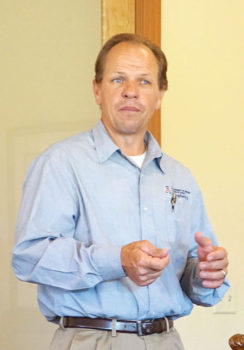
Deputy Director of Biosphere II John Adams spoke at the SaddleBrooke Sunrise Rotary Club.
Dick Kroese
SaddleBrooke Sunrise Rotary Club had John Adams, Deputy Director of Biosphere II, as the speaker at our weekly meeting. He told us that the University of Arizona assumed management of Biosphere 2 in July of 2007. The University has the vision of understanding complex environmental systems by engaging both the scientific community and the public, integrating large-scale experimentation with computational modeling and advancing awareness of the environmental and resource challenges. Four years later, the University of Arizona was gifted the 40-acre Biosphere 2 campus and facilities.
For those that are interested in being a volunteer and learning at the same time, you may contact John Adams at 520-838-5155 or Kevin Bonine at 520-621-0232 and they will give you further information on how you can become a volunteer.
Ken Marich
The United States Peace Dollar was minted to memorialize the peace following World War I. It has an interesting history and has found its way into the hands of all coin collectors. The Peace Dollar was minted from 1921 to 1928 and again in 1934 and 1935. It all started when on May 9, 1921, Congressman Vestal introduced the Peace Dollar proposal. It was not passed until mid-December 1921; however, discussion continued during those eight months and on May 26, 1921, Charles Moore, chairman of the U.S. Commission of Fine Arts and Mint Director Raymond Baker decided that a design competition should be held for the design of the proposed dollar. This idea was formalized on July 26 and submitted to Congress. The proposal also limited competitors to only invited and experienced sculptors. In September the proposal was not passed and put aside. By November, 1921, proponents of the Peace Coin had realized that Congressional approval was not necessary, as the Morgan Dollar had been struck for more than 25 years. The Peace Coin was now eligible for replacement at the discretion of the Secretary of the Treasury under an 1890 act. Thus, on November 19, 1921, James Earle Fraser, the designer of the Buffalo nickel, notified competition participants. He sent them the official rules and requirements. Time was short; the designs were due by December 12. The competitors included Hermon MacNeil, Victor D Brenner and Adolph Weinman all of whom had designed previous U.S. coins. The winner would receive $1500 and the participants would be given $100.
The rules were as follows: Depict the head of Liberty on the obverse, to be made as beautiful and full of character as possible and the reverse would depict an eagle as prescribed by the Coinage Act of 1792, but otherwise was left to the discretion of the artist. The piece also had to bear the denomination, the name of the country, “E pluribus Unum”, the motto “In God We Trust” and the word “Liberty.” On December 13, after considerable discussion, the judging committee selected a design by Anthony de Francisci, the youngest (age 34) of the competitors. De Francisci based the obverse design of Liberty on the features of his wife, Teresa. Within a week, minor modifications were made and the Treasury announced the new design on December 19. The first strike of the Peace Dollar was scheduled for December 29. The Philadelphia Mint reported that 1,006,473 coins were struck in 1921, an amazing feat. The high-relief design kept breaking the dies so the design was modified to low-relief which solved the problem. Between 1921 and 1935 over 188 million Peace Dollars were minted at Philadelphia, Denver and San Francisco. None of the Peace Dollar mintages are particularly rare with the exception of the 1928-P with only 360,649 minted. Peace Dollars contain 90% silver and are worth bullion value (~$15 each). So now you know the rest of the story.
